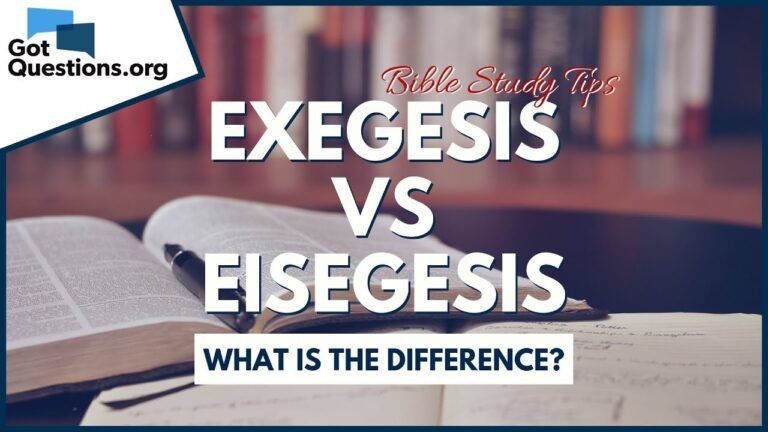Understanding Eisegesis and Exegesis: Key Differences Explained

In the realm of biblical interpretation, the terms eisegesis and exegesis serve as vital concepts that influence how texts are understood and applied. While exegesis involves drawing out the original meaning of a passage based on context and intent, eisegesis refers to the practice of imposing one's own interpretations onto the text. This distinction is vital for anyone seeking to engage deeply with scripture, as it highlights the importance of approaching sacred writings with integrity and respect, ensuring that interpretations remain true to their intended message. Understanding these concepts not only enriches personal study but also fosters meaningful discussions within faith communities.
Boost Your SEO with Our Keyword Tracking Service!
Improve your search engine rankings and drive more relevant traffic to your website.
Learn More!What’s the difference between eisegesis and exegesis?
Eisegesis interprets a text based on personal biases, while exegesis analyzes the text's meaning based on its context and intended message.
What does eisegesis mean in the context of the Bible?
Eisegesis is a method of biblical interpretation that often leads to subjective understandings, as it involves imposing personal beliefs or agendas onto the scripture. Instead of allowing the text to convey its intended message, individuals engaging in eisegesis may distort its meaning by filtering it through their own experiences or preconceived notions.
This approach contrasts sharply with exegesis, which seeks to draw out the original meaning of the text based on context, historical background, and language. By prioritizing personal interpretation over the intended message, eisegesis can obscure the true essence of biblical teachings, potentially leading to misunderstandings and misapplications of scripture in both personal and communal faith contexts.
What are the risks associated with eisegesis?
Eisegesis poses a significant risk by leading individuals to impose their own interpretations on a text, often distorting its intended meaning. This practice can result in misguided assumptions about divine intentions and a false sense of personal insight. When readers project their biases and preconceived notions onto scriptural passages, they may overlook the true message, ultimately undermining the integrity of the text and their understanding of it. By prioritizing personal interpretation over contextual analysis, one risks straying far from the authentic teachings and insights that the text was meant to convey.
Can you provide an example of exegesis?
Exegesis serves as a powerful tool for understanding the deeper meanings behind texts, revealing the author's intended message. For instance, consider a young woman who receives a heartfelt letter from her fiancé. With her emotions at play, she meticulously analyzes each word and phrase, striving to grasp the nuances of his feelings and intentions. In doing so, she embodies the essence of exegesis, as she seeks to uncover the true significance of the message conveyed.
This process of interpretation highlights the importance of context and author's perspective in comprehension. Just as the young lady immerses herself in the letter to discern her fiancé's emotions, exegesis requires readers to delve beyond the surface, considering historical and cultural factors that shape meaning. Ultimately, the goal is to connect with the text on a profound level, ensuring that its interpretation aligns with the original intent of its creator.
Unpacking the Concepts: Eisegesis vs. Exegesis
Understanding the distinction between eisegesis and exegesis is vital for meaningful interpretation of texts, particularly in theological studies. Eisegesis refers to the process of interpreting a text by inserting one's own biases, preconceived notions, or personal beliefs, often leading to skewed conclusions. In contrast, exegesis emphasizes extracting the original meaning and context of the text, allowing for a more accurate understanding of its message. By prioritizing exegesis, readers can engage with the material in a way that respects its intent, fostering deeper insights and richer discussions while avoiding the pitfalls of subjective interpretation.
Clarity in Interpretation: Distinguishing Two Approaches
In the realm of interpretation, clarity is paramount, especially when distinguishing between two prevalent approaches: literal and contextual. The literal approach focuses on the explicit meaning of words, often leading to straightforward conclusions, while the contextual approach delves deeper, considering the surrounding circumstances, cultural nuances, and the intent behind the message. By recognizing the strengths and limitations of each method, interpreters can enhance their understanding and deliver more nuanced insights, ultimately fostering effective communication and reducing the risk of misinterpretation. This balance between precision and context is essential for navigating complex texts and conversations in our increasingly interconnected world.
Navigating Textual Analysis: A Guide to Eisegesis and Exegesis
Understanding textual analysis is essential for interpreting literature, scripture, and any written work. Two fundamental approaches are eisegesis and exegesis. Eisegesis involves imposing one's own interpretations and biases onto a text, often leading to subjective conclusions that may stray from the author's intended meaning. This method can be tempting, as it allows readers to connect personally with the material, but it risks distorting the original message and undermining the integrity of the text.
In contrast, exegesis seeks to uncover the meaning of a text through careful analysis and contextual understanding. This approach emphasizes the importance of historical, cultural, and linguistic factors that shaped the writing. By prioritizing the author's intent and the text's original context, exegesis fosters a more accurate and respectful interpretation. Navigating these two methods equips readers with the tools to engage deeply and thoughtfully with texts, enriching their understanding and appreciation of literature and beyond.
Understanding the distinction between eisegesis and exegesis is vital for anyone engaging with texts, whether sacred or secular. By approaching texts with a commitment to exegesis, readers can uncover the intended meanings and insights that enrich their understanding, rather than imposing their own biases through eisegesis. Embracing this approach not only deepens comprehension but also fosters respectful dialogue and critical thinking, allowing us to appreciate the richness of diverse interpretations while staying grounded in the original context.
